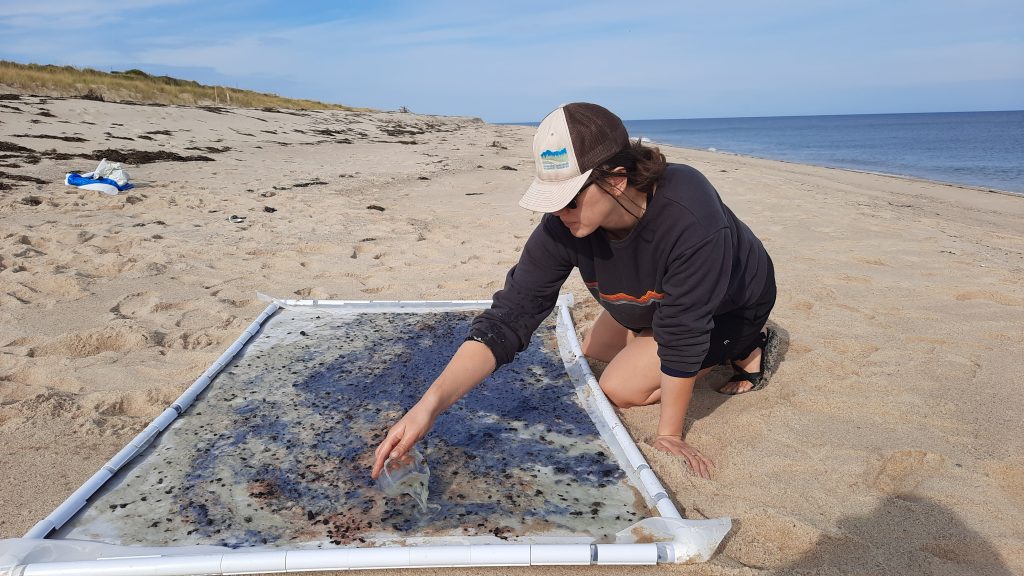
“Through my work, I can create this cultural connection with nature and the places around us,” says this month’s cover artist May Babcock. Babcock forages for inspiration and raw materials where land meets sea. On windswept shores, she wades through tidal pools and combs beaches, gathering cast-off treasures brought in with each alternating rush of the Atlantic. Tangled skeins of kelp and seaweed. Craggy swirls of driftwood. Sandscoured shards of shells and intricate skeletons of marine life.
The ocean offers an endless wellspring of inspiration and raw materials for artists willing to look beneath the surface. Its vast ecosystems provide a boundless palette of colors, textures, and forms that can be harvested and transformed into vibrant works of art. The washes of blue-green hues, from turquoise shallows to indigo depths, make for rich natural pigments when rendered from seaweeds and algae. The sculptural shapes of driftwood, woven patterns of kelp fronds, and the intricate skeletons of marine life lend themselves to texture-rich printmaking, collages, and 3D mixed-media assemblages. Even the ocean’s sands, shells, and biogenic sediments can be sustainably gathered and reconstituted into handmade paper-making canvases embodying the fluid energy of wind and waves. For artists aligned with environmental and sustainability values, the ocean proffers an abundance of evocative materials that can be respectfully collected and upcycled into compelling conceptual works sparking awareness and activism. This passionate interdisciplinary approach has garnered international recognition for Babcock’s marine-inspired creations amid a rising tide of ecocentric art. Her pieces grace the permanent collections of coastal institutions such as the Ogden Museum of Southern Art, punctuate waterfront public spaces, and make waves in publications focused on the overlapping worlds of craft, printmaking, book arts, and environmental activism.

Back in her studio, she alchemizes her naturalistic collections into visually stunning yet environmentally conscious works. Displaced plants get refashioned into handmade sheets of paper formed through ancient techniques to create lush, relief prints, and mixed media musings on our fragile relationship with water systems.
“I started making my own inks using indigo and turmeric, so these are all-natural inks and pigments I’m using for my art.” Her unique creative process serves as both a reciprocal dialogue and poetic mirror of the complex aquatic ecosystems she’s committed to understanding and protecting.
Babcock’s ecocentric oeuvre emerges from unlikely marriages of tradition and innovation. Ancient Han-era techniques for transforming barks into malleable paper pulps find new life when paired with meticulous cyanotype photograms of delicate underwater flora. Luscious natural dyes extracted from cherished invasive species become vehicles for raising awareness through visually resplendent abstract compositions.
Whether sculpting lacy three-dimensional bas-relief landscapes from sediment-rich cotton rag or bookbinding tales of environmental stewardship upon vibrant, soil-hued pages, Babcock wields these natural materials in a masterful contemporary fusion of artistic disciplines. Her work adeptly melds the traditions of book arts, printmaking, craft, sculpture, and installation into a distinctly ecocentric practice.
Babcock remains firmly anchored to her core mission — forging an intimate artistic dialogue with the restorative power and vulnerable beauty of the world’s oceans and waterways.
Babcock has also brought her passion for papermaking and sustainability to the digital realm through her online platform paperslurry.com and the Paperslurry Weekly newsletter. This virtual creative community serves as an educational hub where artists of all levels can learn Babcock’s innovative techniques for transforming foraged natural materials into vibrantly textured handmade papers and pigments. Through in-depth video tutorials, stepby-step workshops, and a lively forum for sharing works in progress, subscribers get an intimate look into Babcock’s unique artistic processes while embarking on their own ecocentric papermaking journeys. The online classes extol using sustainably sourced local ingredients like leaves, stones, clay, and invasive plants, emphasizing how any bioregion can become a treasure trove of raw materials when explored through Babcock’s codifying yet poetic lens. As both a practical guide and philosophical manifesto, her virtual teachings empower students to reframe their relationship to nature’s discarded scraps and breathe new life into the ancient art of papermaking.